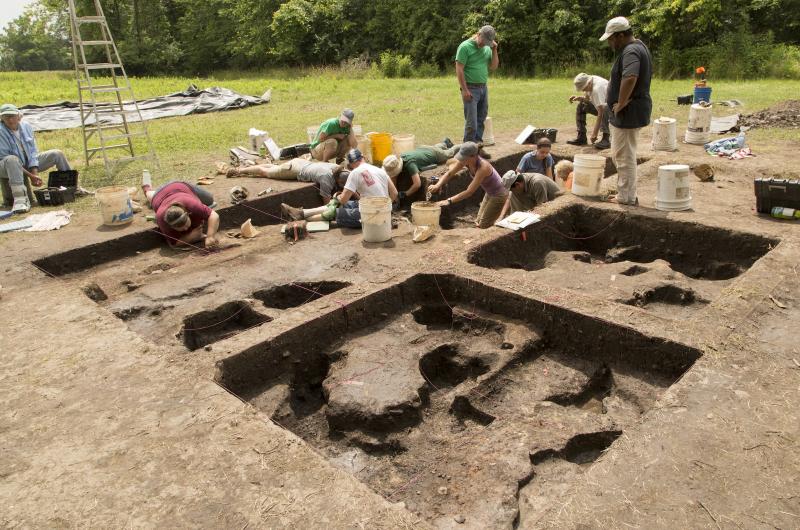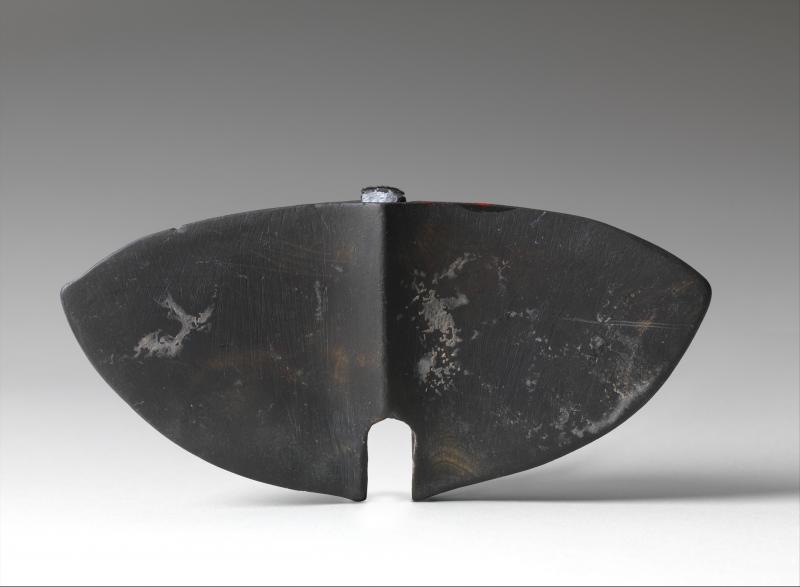The stately Burrell homestead was built in 1820. It’s one of the oldest buildings in Lorain County. But nearby, in what was once the estate’s orchard, are the remains of much older habitations.
 “This is a 4,000 year-old house floor,” says Brian Redmond, head of archaeology at the Cleveland Museum of Natural History, pointing to a smooth patch of yellow clay. Redmond and his team led digs this summer that revealed ancient living spaces buried beneath this grassy field. “This is a 4,000 year-old house floor,” says Brian Redmond, head of archaeology at the Cleveland Museum of Natural History, pointing to a smooth patch of yellow clay. Redmond and his team led digs this summer that revealed ancient living spaces buried beneath this grassy field.
He points to a neatly dissected pit.
“Those are actually subfloors," says Redmond, "one on top of the other that’s been built in this place, as if they’re reflooring their house structure.”
It’s a unique find.

New ground for Ohio
Clay floors like this have been found farther south in Kentucky or parts of Illinois, says Redmond, but never before in Ohio.
The floor was enclosed by an oblong shaped house. He points to a series of dark patches around the floor’s edge.
“Those are remains of stains left behind by wooden posts," Redmond explains. The round marks are organic staining, "from wooden posts that have rotted away.”
Spiritual offering found in floor
Just outside the house Redmond and his crew found a pile of deer bones -- perhaps the remains of a stew pot -- plus nutshells and several stone tools. But inside – not much.
 “People swept their floor,” he says. “People swept their floor,” he says.
But he did find one special item inside the house, buried in a shallow depression.
Redmond had found part of a bannerstone.
It’s a diamond-shaped piece of slate with a hole drilled down the middle. It was used as a counterweight for an ancient spear thrower or atlatl. He thinks this one was ritually broken and buried beneath the floor.
“It’s thought that bannerstones were both utilitarian; they were weights on spear throwers, but they might also have some symbolic importance.”
Back at the museum, Redmond shows me the artifact itself.
Before bows and arrows arrived in Ohio, people used spears and spear throwers to hunt game. The bannerstone helped hold the spear steady, but Redmond says its artful design and ritual burial show it meant more.
Archeologists are often focused on the "mundane everyday activities" of ancient peoples, says Redmond, but symbolic objects like the bannerstone reminds him that "they had a spiritual life as well.”
Mysteries of the archaic
Of all the periods of Ohio’s prehistory, the 7,000 year stretch known as the archaic, from 8,000 BC to 1,000 BC, is the least understood, according to Kent State anthropologist Linda Spurlock.
“But there were dynamic things happening at the time," says Spurlock, "especially toward the end as the population size increased.”
People were starting to live in one place for longer periods, like at the site in Sheffield Village.
“People are settling into areas and learning to extract a living very carefully from the local resources,” she says.
 Base camps Base camps
Back at the site, Redmond is digging another test pit. He says the dirt all around us contains relics of ancient habitation.
He believes most of the large field next to the Burrell homestead was once home to ancient peoples, “This is all late archaic, 4,000-year-old deposits, and it’s pretty much everywhere under our feet.”
But archaeologists hesitate to call such a grouping of homes a 'village." Instead he calls it a "seasonal base camp."
In fact, Redmond says archaic people lived here off and on for at least 500 years, primarily during the fall and winter months, living off the land with plenty of hickory nuts, deer and fish from Lake Erie and the Black River.
It's an ideal locale for a campsite, on a little bit of a bluff that sticks up, just a mile or so out to the lake.”
But there was no corn; that Native American staple hadn’t reached Ohio yet. Neither had pottery.
Volunteers at the museum are cataloging the dozens of stone tools, animal bones, and other artifacts found at the Burrell Orchard site.
Redmond says they’ll eventually go on display in the museum’s upcoming expansion, part of a gallery called ‘The First Ohioans.’ |